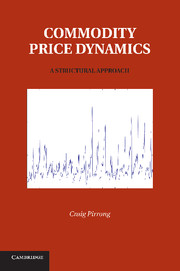Book contents
- Frontmatter
- Contents
- Preface
- 1 Introduction
- 2 The Basics of Storable Commodity Modeling
- 3 High-Frequency Price Dynamics for Continuously Produced Commodities in a Two-Factor Storage Economy: Implications for Derivatives Pricing
- 4 The Empirical Performance of the Two-Factor Storage Model
- 5 Stochastic Fundamental Volatility, Speculation, and Commodity Storage
- 6 The Pricing of Seasonal Commodities
- 7 The Dynamics of Carbon Markets
- 8 The Structural Modeling of Non-Storables: Electricity
- References
- Author Index
- Subject Index
2 - The Basics of Storable Commodity Modeling
Published online by Cambridge University Press: 05 June 2012
- Frontmatter
- Contents
- Preface
- 1 Introduction
- 2 The Basics of Storable Commodity Modeling
- 3 High-Frequency Price Dynamics for Continuously Produced Commodities in a Two-Factor Storage Economy: Implications for Derivatives Pricing
- 4 The Empirical Performance of the Two-Factor Storage Model
- 5 Stochastic Fundamental Volatility, Speculation, and Commodity Storage
- 6 The Pricing of Seasonal Commodities
- 7 The Dynamics of Carbon Markets
- 8 The Structural Modeling of Non-Storables: Electricity
- References
- Author Index
- Subject Index
Summary
Introduction
Many important commodities are storable. These include grains, many energy products such as oil and natural gas, and industrial and precious metals. Because of the ability to store, agents have the ability to influence the allocation of consumption of these products over time. Moreover, they typically do so under conditions of uncertainty. Because finance is at root the study of the allocation of resources over time in risky circumstances, the commodity storage problem is fundamentally a problem in finance. Indeed, it is the Ur problem (or pre-Ur problem) of finance: humans have had to make decisions about how to allocate consumption of commodities over time since the dawn of agriculture.
Even a brief consideration of the economics of storage demonstrates that although the problem is a very old one, it is a very challenging one analytically. The problem is inherently a dynamic one with complicated intertemporal dependencies. Storage involves an opportunity cost. If I own a bushel of wheat, I can consume it today or store it for consumption tomorrow – or later. The opportunity cost of consumption today is the value of the commodity tomorrow. I must also pay a physical storage cost and forego any interest I could earn on the money I spend to buy the economy. But under conditions of uncertainty (about future supply or demand, say), the value of the commodity tomorrow is uncertain.
- Type
- Chapter
- Information
- Commodity Price DynamicsA Structural Approach, pp. 18 - 43Publisher: Cambridge University PressPrint publication year: 2011



